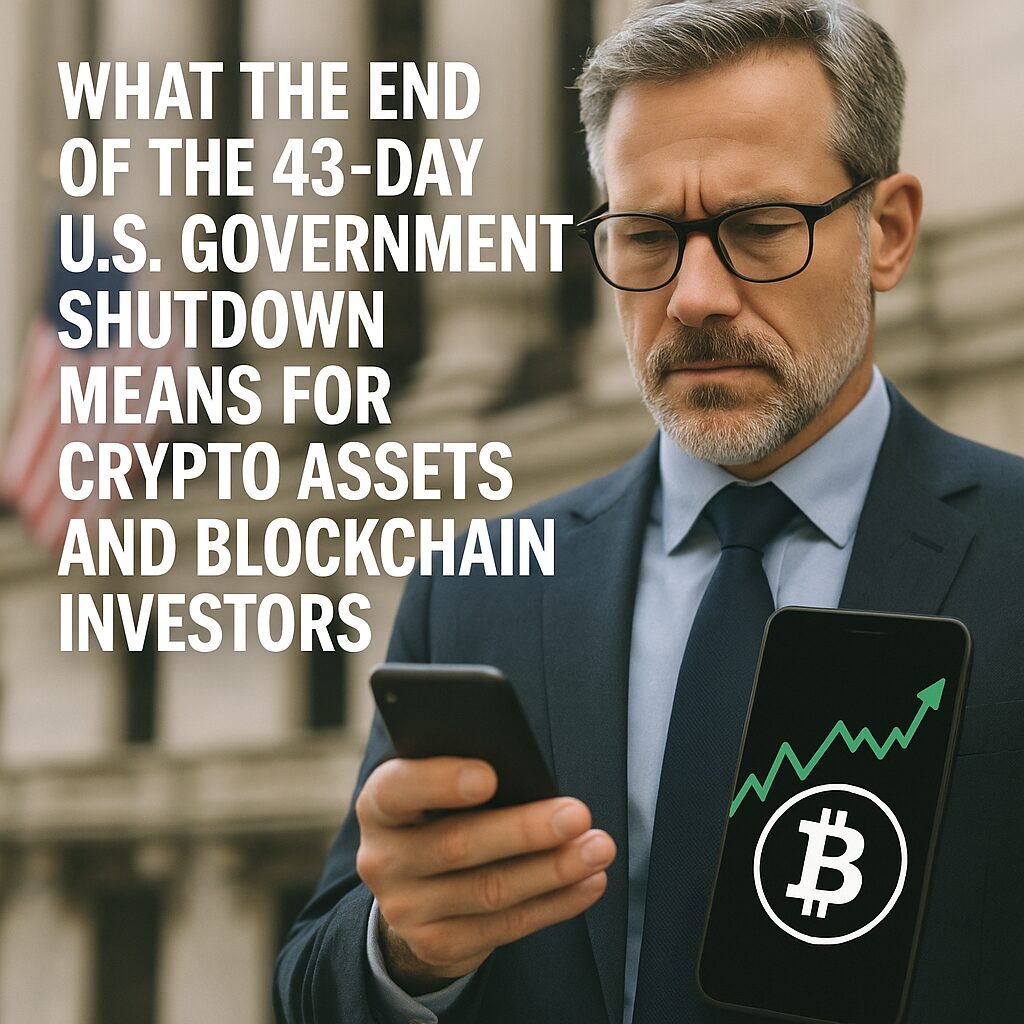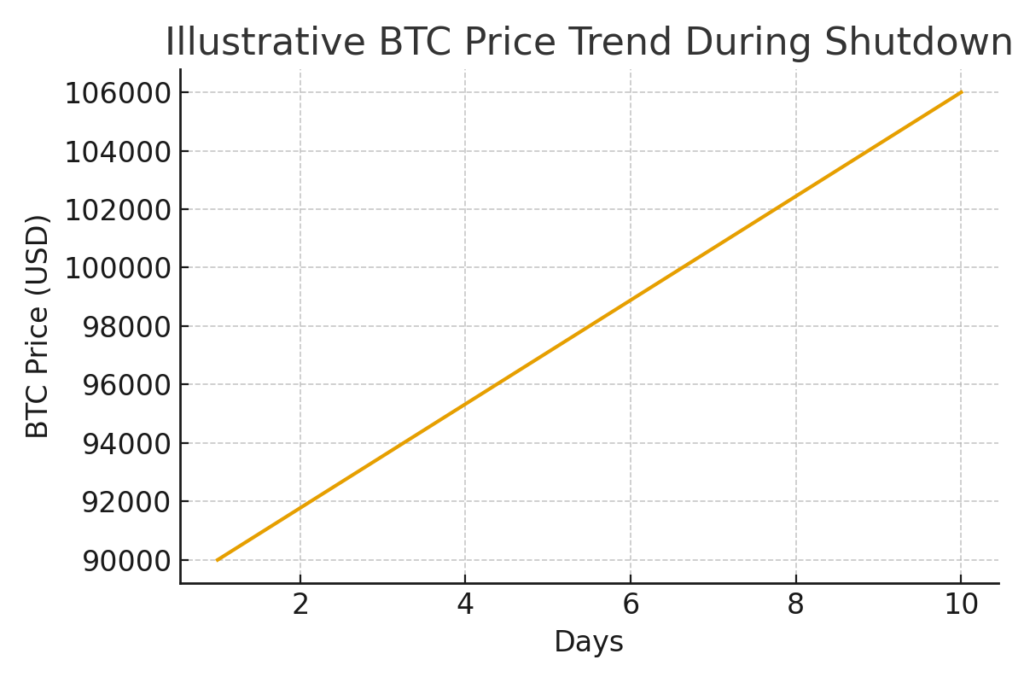
Key Points :
- The U.S. federal government shutdown lasted 43 days, the longest in American history, and ended with a budget bill signed by President Donald Trump, securing funding through January 30, 2026.
- During the shutdown, key federal regulators such as the U.S. Securities and Exchange Commission (SEC) and the Commodity Futures Trading Commission (CFTC) were operating at minimal capacity, delaying crypto-related regulatory decisions including ETF reviews.
- With the reopening of government operations, liquidity is expected to return. The crypto-market has already shown notable gains: for instance, XRP surged by around 10 % in response to news of the shutdown resolution and renewed optimism around spot-XRP ETF launches.
- The budget deal’s passage is interpreted as a signal of reduced regulatory gridlock. Crypto investors are watching closely for the resumption of rule-making and approvals (including spot altcoin ETFs) which had been stalled.
- The pause in government operations may have weighed on market liquidity: with federal revenues flowing into the Treasury General Account (TGA) instead of being spent, some analysts view the reopening as a potential catalyst for renewed capital flows into risk assets—including crypto.
1. Shutdown Background & Immediate Impact
The U.S. federal government entered a shutdown beginning October 1, 2025, due to a budget impasse largely over healthcare subsidies and tax credits relating to the Affordable Care Act. The disagreement led to a halt of many government operations, affecting federal employees, contractors, regulatory agencies and broader markets.
With the signing by President Trump of a continuing resolution (CR) on November 13, 2025, the shutdown was officially ended at 43 days — the longest in U.S. history. According to the reports, the House approved the bill 222-209, and the funding is secured up to January 30, 2026.
The shutdown caused wide disruption: more than one million federal employees were furloughed or worked without pay; many government services, such as preschool programs, food assistance, and federal monuments, were suspended. The federal regulators relevant to crypto and financial markets – notably the SEC and the CFTC – operated on skeleton crews and delayed routine actions.
2. Why Crypto Markets Care: Regulation, Liquidity, and Sentiment
2.1. Regulatory Freeze
One of the major implications of the shutdown for crypto was that regulatory agencies essentially froze non-emergency operations. For instance:
- The SEC postponed many asset-class reviews, including those for spot crypto ETFs.
- The CFTC likewise lost momentum in advancing guidance around leveraged spot crypto products.
In effect, policy clarity and approvals crucial for broader institutional participation in crypto were delayed.
2.2. Liquidity Drag

The shutdown also impacted macro-liquidity conditions. Because federal outlays were curtailed, but tax receipts and bond issuance continued, the TGA at the Federal Reserve swelled, effectively pulling liquidity from markets. Analysts note that during the shutdown, this created a “black hole” effect, restraining money available for risk assets.
As government functions resume, that withheld spending may gradually return to the economy, improving liquidity and thereby risk-asset sentiment, including for crypto.
2.3. Market Sentiment & Altcoin Pivot
Crypto markets are highly sensitive to macro and regulatory signals. With signs of resolution in Washington, many altcoins – especially XRP – have rallied in anticipation of renewed institutional flows and product launches. For instance, the price of XRP jumped approximately 10–12 % after budget progress was reported.
This rally reflects not just short-term sentiment but an anticipatory move toward potential structural changes: the launch of spot altcoin ETFs, improved regulatory clarity, and institutional adoption.
3. Spotlight on XRP & Altcoin ETF Landscape

The reopening of government operations has particular relevance to the altcoin investment thesis—especially the case of XRP. Several developments stand out:
- According to a report, 11 XRP-linked ETF products appeared on the DTCC (“Depository Trust & Clearing Corporation”) website in “active and pre-launch” status, including issuers such as 21Shares, ProShares, Bitwise, Canary Capital, CoinShares, and Franklin Templeton.
- Market experts suggest the end of the shutdown may clear procedural bottlenecks at the SEC, enabling first launches of spot altcoin ETFs (including XRP) under the Securities Act of 1933.
- A broader altcoin narrative is emerging: with Bitcoin and Ethereum already well-known, altcoins like XRP now stand to benefit if institutional infrastructure catches up. For investors hunting new sources of yield or right-of-entry into next-wave crypto assets, this shift is material.
4. Broader Market Implications & Blockchain Use Cases
4.1. Macro Return to Risk Assets
With the government reopening, risk assets more driven by regulatory clarity and liquidity are expected to participate. Crypto’s performance amid this backdrop suggests resurgence in appetite. For example, reports show Bitcoin (BTC) climbed past $106,000 as the shutdown resolution moved ahead.
Historically, following the 2018–2019 U.S. shutdown, Bitcoin rallied nearly 300 % in five months — analysts are now asking if a similar albeit more muted move could be in play.
4.2. Institutional Blockchain Infrastructure
Resumption of regulatory and operational functions implies that institutional and enterprise blockchain initiatives may restart or accelerate. For blockchain practitioners and investors, the importance is twofold:
- Productisation: Spot-crypto ETFs, tokenised assets, stablecoins—all benefit from regulatory momentum. The reopening re-energises the pipeline of approvals.
- Operational Use-Cases: With federal agencies and contractors returning to business, blockchain applies in payments, identity, supply-chain tracking, and tokenisation may receive renewed government interest. For example, government-issued contracts and payments delayed during the shutdown will now resume, and blockchain may feature in tracking or automating processes.
4.3. New Investment Opportunities
For the reader seeking new crypto assets or revenue streams:
- Altcoin ETFs: With XRP at the front of this wave, early entry may benefit from the “first mover” effect in altcoin institutional products.
- Blockchain Infrastructure Plays: Projects supporting tokenisation of government or corporate payments may gain renewed relevance.
- On-chain Yield/Utility: The return of macro liquidity may drive new flows into DeFi and tokenised real-world-asset protocols as hedge strategies for institutional investors.
5. Risks & Considerations
While the end of the shutdown is a positive signal, several caveats remain:
- The mere appearance of ETF tickers or product listings (such as on DTCC) does not guarantee regulatory approval or successful launch. Investors should exercise caution and perform due diligence.
- Macro and regulatory conditions remain complex: the Federal Reserve may react to delayed economic data (jobs, inflation) resulting from the shutdown, possibly delaying monetary easing and thus reducing risk-asset upside.
- Valuation levels for major assets are already elevated (for example, Bitcoin at ~$106,000). While growth is possible, the magnitude may be moderated compared to earlier phases.
- Blockchain infrastructure and adoption timelines remain subject to execution risk: regulatory clarity does not guarantee immediate rollout of enterprise use‐cases.
6. What This Means for You (Crypto/Blockchain Practitioner)
- Stay alert to ETF launches: For investors seeking new crypto assets, the coming weeks may bring formal launches of spot altcoin ETFs—especially XRP-linked. Early awareness (though not necessarily early speculative entry) could provide advantage.
- Evaluate infrastructure plays: For blockchain developers and practitioners, the reopening may revive procurement and regulatory-driven projects. Consider how your skills or project may align with renewed agency or enterprise blockchain spend.
- Monitor liquidity and sentiment flows: As governmental spending and payments resume, liquidity may shift into risk assets—and crypto is positioned to benefit. Tracking on-chain metrics, ETF flows and institutional announcements will provide ahead-of-curve signals.
- Maintain risk management: Elevated valuations and macro risks (inflation, interest-rates, regulatory reversal) mean that entry timing, position size, and diversification remain key.
Conclusion
The end of the 43-day shutdown of the U.S. federal government marks more than a political milestone — it represents a potential turning point for the crypto and blockchain ecosystem. With regulators returning to work, institutional infrastructure moving forward (for instance, spot altcoin ETFs), and liquidity beginning to flow back into risk assets, the environment is reopening for blockchain-centric opportunities.
For those hunting new crypto assets or exploring practical blockchain use-cases, this moment offers a fresh vantage point: the institutionalisation of altcoins like XRP, renewed enterprise blockchain interest, and a macro frame where liquidity and sentiment may favour digital assets.
That said, elevated valuations, macro uncertainties, and regulatory nuances call for measured optimism. For practitioners and investors alike, this is a time to prepare—aligning strategy, watching signals closely, and being ready to act as structural catalysts unfold.

